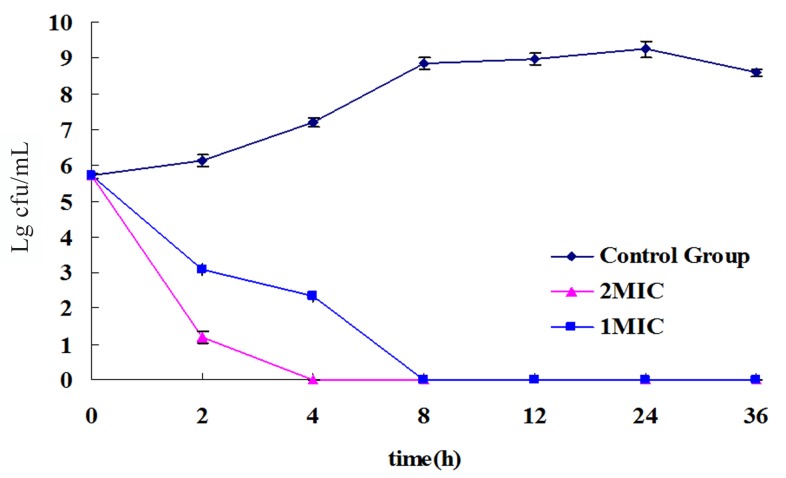Abstract
The antibacterial effect of α-terpineol from Cinnamomum longepaniculatum (Gamble) N. Chao leaf essential oils were studied with special reference to the mechanism of inhibiting the standard strain of Escherichia coli (CMCC (B) 44102) growth at ultrastructural level. Minimal inhibitory concentration (MIC) and minimal bactericidal concentration (MBC) and time-kill curves of α-terpineol were determined; Escherichia coli was treated with α-terpineol and observed under a transmission electron microscope. The MIC and MBC values of α-terpineol were all 0.78 μL/mL, and time-kill curves showed the concentration-dependent. Under the transmission electron microscopy (TEM), Escherichia coli exposed to MIC levels of α-terpineol exhibited decreased cell size and irregular cell shape, cell wall and cell membrane were ruptured, nucleus cytoplasm was reduced and nuclear area gathered aside. Results suggest that α-terpineol has excellent antibacterial activity and could induce morphological changes of Escherichia coli.
Keywords: α-terpineol, Escherichia coli, antibacterial activity, TEM
Intruduction
In recent years there is increasing incidence of multiple resistance in human and animal pathogenic microorganisms, largely due to the indiscriminate use of commercial antimicrobial drugs commonly employed in the treatment of animal and human infectious diseases (Zewdu and Cornelius, 2009). So it is necessary to screen new antimicrobial substances from various sources like medicinal plants (Ghasemi et al., 2010).
Cinnamomum longepaniculatum (Gamble) N. Chao ex H. W. Li belongs to the Lauraceae and grows widely in Sichuan and Taiwan of China (Tao et al., 2002). Preliminary studies have showed that the C. longepaniculatum leaf essential oils has strong antibacterial activities (Wei et al., 2009; Tao et al., 2011). It is often employed by the pharmaceutical industry in drug formulations, as a percutaneous penetration enhancer and for its decongestant and antitussive effects (Williams et al., 1991; Levison et al., 1994). In Sichuan Province, α-terpineol is the major component of C. longepaniculatum leaf essential oils, comprising ca 15.43% (Huang et al., 1986) of whole oil. Meanwhile, the effect on the ultrastructural structure of α-terpineol against bacteria has never been reported. So the objective of this study is to evaluate potential antibacterial activity of α-terpineol and investigate under a transmission electron microscope (TEM) the morphological changes in Escherichia coli as a result of exposure to α-terpineol.
Materials and Methods
Microbial strain and chemicals
Standard strain of Escherichia coli (CMCC (B) 44102) was supplied by Department of Food Science and Technology Sichuan Agricultural University, Ya’an, China. Mueller-Hinton broth and Nutrient agar medium were purchased from Beijing Aobo Star Biotechnology Company Limited. α-Terpineol (99%) was obtained from Sichuan Perfumery Co., Ltd, Yibin, China.
Antibacterial susceptibility test
MIC and MBC values of Escherichia coli were determined by broth dilution method described in the National Committee for Clinical Laboratory Standards (NCCLS, 2008). The test samples were dissolved in 2.5% Tween-80 at a final concentration ranging from 12.5 μL/mL to 0.098 μL/mL. 2.5%Tween-80 was used as negative control. Measured the values of OD600 of α-terpineol by UV spectrophotometer and measured once again after 24 h of incubation at 37 °C. The test tube with the same value of OD600 after 24 h, showing that there were no Escherichia coli colonies growing that is the value of MIC (Hu. et al., 2009). MBC was estimated as the least concentration of the samples where no visible growth on nutrient agar medium. All the experiments were performed in triplicate and the results were averaged.
Time-kill curve study of α-terpineol
Time-kill curve studies were performed in duplicates with the α-terpineol and broth culture prepared on the day of the experiment at 2 different levels as follows: 1 × MIC and 2 × MIC. α-terpineol at various levels and with growth control group were seeded with a log-phase inoculum of roughly 1 × 107 cfu/mL to a final volume of 10 mL. Inoculated broths were incubated at 37 °C. 0.1 mL of inoculated broths were sampled at different time intervals (0, 2, 4, 8, 12, 24 and 36 h) from each tube and was subjected to 10-fold serial dilution. Then, 0.1 mL of every dilution was spread on Mueller-Hinton plates and incubated at 37 °C for 24 h. Only plates containing the Escherichia coli colonies amounts between 30–300 for each series of dilutions were counted. Finally, the time-kill curve was constructed for organism (Zhang et al., 2010).
Transmission electron microscopy
10 mL of 107 cfu/mL Escherichia coli suspensions were exposed to MIC concentration of α-terpineol and then were incubated at 37 °C for 1 h, 2 h and 4 h in an incubator shaker. The control group was treated with solvent only. The Escherichia coli suspensions were centrifuged in sterile plastic centrifuge tubes at 8000 g for 15 min at 4 °C and were washed with three consecutive (15 min) washes with cacodylate-buffer. Then the supernatant was discarded and the pelleted cellular content was fixed with 2.5% glutaraldehyde in 0.1 mol/L cacodylate-buffer (pH = 7.2) at 4 °C overnight. Samples were then post-fixed for 2 h in 1% osmium tetroxide (OsO4) dissolved in cacodylate-buffer at room temperature and washed in cacodylate-buffer (three times, 15 min each). Samples were dehydrated in ethanol in a graded series of 40%, 60%, 75%, 80% and 95% dilutions for 15 min each. A final dehydration step was carried out for 1 h in 100% ethanol with changes every 30 min. Epoxy resin (Epon-618) was used to embed the post-fixed samples for 12 h-16 h at 45 °C. Ultra thin section of the embedded samples were prepared by LKB-II Ultracut instrument and double stained with uranyl acetate and lead citrate. Morphology of the Escherichia coli cells was observed on a transmission electron microscope (Tao et al., 2011).
Results and Discussion
Antibacterial activity of α-terpineol
The MIC and MBC values of α-terpineol against Escherichia coli were all 0.78 μL/mL. It means that α-terpineol might inhibit the growth of Escherichia coli by killing bacteria directly.
Study has shown that (Wei, 2009) the C. longepaniculatum leaf essential oils has strong antibacterial activity on Escherichia coli, which the MIC and MBC value of C. longepaniculatum leaf essential oils was 3.13 μL/mL. Compared with C. longepaniculatum leaf essential oils, α-terpineol has a stronger antibacterial activity than C. longepaniculatum leaf essential oils. Moreover, the antimicrobial activity of α-terpineol on Salmonella enteritidis and Staphylococcus aureus has been investigated in our laboratory. The result showed α-terpineol has the same strong antibacterial activities against Salmonella enteritidis and Staphylococcus aureus, which the MIC and MBC values were 1.56 μL/mL and 3.13 μL/mL respectively. Otherwise, α-terpineol also exhibited strong antimicrobial activity against periodontopathic and cariogenic bacteria (Park, 2012).
Time-kill curve of α-terpineol against Escherichia coli
Time-kill curves of α-terpineol (Figure 1) showed that the time-kill curve of control group of α-terpineol had the integral growth cycle (lag phase, logarithmic phase, stationary phase and death phase). But at 1 × MIC and 2 × MIC concentration of α-terpineol, Escherichia coli directly entered into decline phase without adjustment phase; logarithmic phase and stable phase. All the bacterial cells of Escherichia coli were killed by α-terpineol at 1 × MIC in 8 h and 2 × MIC in 4 h, the rate of killing increased by increasing the concentration of α-terpineol. The resulting time-kill curve approach described the interaction between bacteria and α-terpineol in a dimensional way by a dynamic of integration of concentration and time, and the results proved the concentration dependent type (Pu et al., 2010). This will be a more rational basis for determining optimal dosage for antimicrobial treatment regimens.
Figure 1.
The Time-kill curves of α-terpineol against Escherichia coli (each experiment in triplicate).
Ultrastructural changes of Escherichia coli
A transmission electron microscopic study of untreated cells of Escherichia coli showed a typical healthy bacilli-shape and clear integrated cell structure containing a continuous smooth cell wall, cell membrane, nuclear area (Figure 2 A). Besides, Escherichia coli cytoplasm uniform distributed evenly and nuclear area stained slightly (Figure 2 B).
Figure 2.
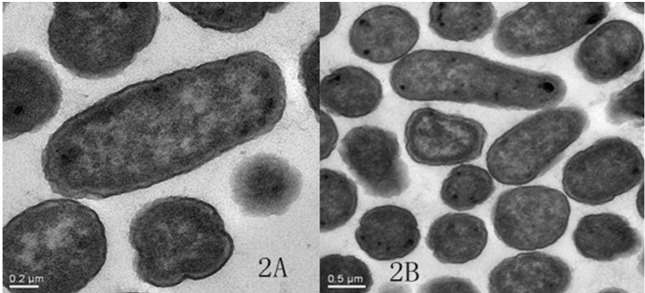
TEM graph (A, × 40000) of Escherichia coli kept normal morphology; TEM graph (B, × 25000) of Escherichia coli cytoplasm uniform distributed evenly and nuclear area stained slightly.
Cells of Escherichia coli exposed to MIC concentration of α-terpineol exhibited different changes during different time periods. Escherichia coli cell wall and cell membrane became thinner (Figure 3A, black arrows) and cytoplasmic material showed clumping (Figure 3A, white arrows) of after 1 h; The nuclear area was on the edge of cell (Figure 3B, arrows).
Figure 3.
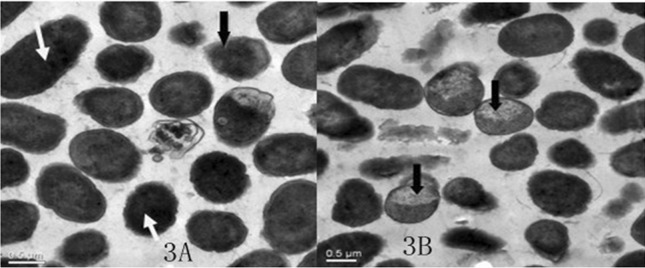
TEM graph of Escherichia coli exposed to MIC value of α-terpineol for 1 h. Escherichia coli cell wall and cell membrane became thinner (A, × 25000, black arrows) and cytoplasmic material showed clumping (A, × 25000, white arrows). The nuclear area was on the edge of cell (B, × 25000, arrows).
After 2 h, cells of Escherichia coli exhibited decreased size, irregular shape, thin cell wall, some cells stained slightly(Figure 4A, black arrows) and some cells stained deepen (Figure 4A, white arrows); Cytoplasm of Escherichia coli had lost its even distribution and cells unequal division emerge (Figure 4B, arrows).
Figure 4.
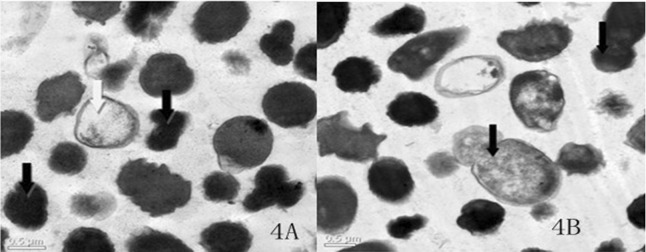
TEM graph of Escherichia coli exposed to MIC value of α-terpineol for 2 h. Decreased cell size and irregular cell shape. Some cells (A, × 25000, black arrows) stained slightly and some cells (A, × 25000, white arrows) stained deepen. Cytoplasm uneven distribution and cells unequal division (B, × 25000, arrows).
After 4 h, Escherichia coli cells were forced to gather except the decreased cell size and irregular cell shape; Cytoplasm had lost and the most cells stained slightly (Figure 5A, arrows); Plasmolysis and bubble appeared in the cell (Figure 5B, arrows).
Figure 5.
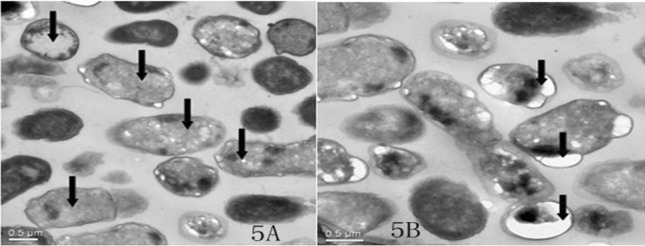
TEM graph of Escherichia coli exposed to MIC value of α-terpineol for 4 h. Cytoplasm had lost and the most cells stained slightly (A, x 25000, arrows). Plasmolysis and bubble appeared (B, x 25000, arrows).
The main morphostructural alterations in Escherichia coli induced by α-terpineol performanced in decreased cell size, irregular cell shape, cytoplasm condensed, cytoplasm lost, nuclear area edged, plasmolysis, unequal division and vacuolization of cell. The research results showed that, most likely, the antibacterial mechanism of α-terpineol on Escherichia coli was realized through producing alterations on the structure of Escherichia coli directly. The antibacterial mechanism of many anti-bacterial herbal medicines was achieved by destroying the structure of cell directly and affecting the metabolism of cell (Sun and Wu, 2007). Berberine, achieves the antibacterial effect on Staphylococcus aureus by inhibition of, respiratory, glucose metabolism, synthesis of protein and nucleic acid; The mechanism of berberine on Shigella flexneri is to influence the respiratory process by inhibiting the oxidation process of aspartic acid and sodium succinate and Allicin, interfere with bacterial metabolism and achieve the effect of inhibition of bacterial growth ultimately by linking with thiol in cysteine molecules that is necessary for bacterial growth (Sun and Wu, 2007). The marked action of oil components might have conferred lipophilic properties and the ability to penetrate the plasma membrane (Knobloch et al., 1989), which can cause the changes of membrane permeability and loss of the important nutrients in the cell such as enzymes, phosphoric acid, electrolytes, amino acids and nucleic acids, leading to cell death (Sangetha et al., 2009; Rasooli et al., 2006; Pothakamury et al., 1997). As tea tree oil, carvacrol and thymol were all known to disrupt the cytoplasmic membrane and increase its permeability and depolarizes its potential (Xu et al., 2008). The results are comparable to the action of α-terpineol. Besides, It was showed that the presence of free hydroxyl group is essential for antimicrobial activity of carvacrol and that this compound could act as a protonophore (Ben Arfa et al., 2006), which is applicable for α-terpineol.
In conclusion, this study demonstrates that α-terpineol has excellent antibacterial activitiy and the antibacterial mechanism of α-terpineol against Escherichia coli was realized through producing alterations on the structure of Escherichia coli directly. It might have good potential to be used for medical purposes.
Acknowledgments
This study was supported by Sichuan Youth Science and Technology Innovation Research Team for waterfowl disease prevention and control (2013TD0015), and National Natural Science Foundation of China (Grant No.31372477). The authors thank Department of Food Science and Technology, Sichuan Agricultural University, Ya’an, China for supplying microorganism bacterium.
References
- Ben Arfa A, Combes S, Preziosi-Belloy L, Gontard N, Chalier P. Antimicrobial activity of carvacrol related to its chemical structure. Lett Appl Microbiol. 2006;43:149–154. doi: 10.1111/j.1472-765X.2006.01938.x. [DOI] [PubMed] [Google Scholar]; Ben Arfa A, Combes S, Preziosi-Belloy L, Gontard N, Chalier P (2006) Antimicrobial activity of carvacrol related to its chemical structure. Lett Appl Microbiol 43:149–154. [DOI] [PubMed]
- Ghasemi PA, Jahanbazi P, Enteshari S, Malekpoor F, Hamedi B. Antimicrobial activity of some Iranian medicinal plants. Arch Biol Sci. 2010;62:633–641. [Google Scholar]; Ghasemi PA, Jahanbazi P, Enteshari S, Malekpoor F, Hamedi B(2010) Antimicrobial activity of some Iranian medicinal plants. Arch Biol Sci 62:633–641.
- Hu HS, Hu HB, Zheng XD. Study on chemical constituents and antimicrobial activity of the essential oil from Acanthopanax brachypus. J Chinese Med Mater. 2009;32:67–70. [PubMed] [Google Scholar]; Hu HS, Hu HB, Zheng XD (2009) Study on chemical constituents and antimicrobial activity of the essential oil from Acanthopanax brachypus. J Chinese Med Mater 32:67–70. [PubMed]
- Knobloch K, Pauli A, Iberl B, Weigand H, Weis N. Antibacterial and antifungal properties of essential oil components. J Essent Oil Res. 1989;1:119–128. [Google Scholar]; Knobloch K, Pauli A, Iberl B, Weigand H, Weis N (1989) Antibacterial and antifungal properties of essential oil components. J Essent Oil Res 1:119–128.
- Levison KK, Takayama K, Okabe K, Nagai T. Formulation optimization of indomethacin gels containing a combination of three kinds of cyclic monoterpenes as percutaneous penetration enhancers. J Pharm Pharmacol. 1994;83:1367–1372. doi: 10.1002/jps.2600830932. [DOI] [PubMed] [Google Scholar]; Levison KK, Takayama K, Okabe K, Nagai T (1994) Formulation optimization of indomethacin gels containing a combination of three kinds of cyclic monoterpenes as percutaneous penetration enhancers. J Pharm Pharmacol, 83:1367–1372. [DOI] [PubMed]
- National Committee for Clinical Laboratory Standards Performance standards for antimicrobial susceptibility testing. Ninth International Supplement M100-S9; Wayne, PA. 2008. [Google Scholar]; National Committee for Clinical Laboratory Standards (2008) Performance standards for antimicrobial susceptibility testing. Ninth International Supplement M100-S9; Wayne, PA.
- Pothakamury U, Barbosa-Cánovas G, Swanson B, Spence K. Ultrastructural changes in Staphylococcus aureus treated with pulsed electric fields. Food Sci Tech Int. 1997;3:113–121. [Google Scholar]; Pothakamury U, Barbosa-Cánovas G, Swanson B, Spence K (1997) Ultrastructural changes in Staphylococcus aureus treated with pulsed electric fields. Food Sci Tech Int 3:113–121.
- Pu ZH, Zhang YQ, Yin ZQ, Xu J, Jia RY, Lu Y, Yang F. Antibacterial activity of 9-octadecanoic acid-hexadecanoic acid-tetrahydrofuran-3, 4-diyl ester from neem oil. Agr Sci China. 2010;9:1236–1240. [Google Scholar]; Pu ZH, Zhang YQ, Yin ZQ, Xu J, Jia RY, Lu Y, Yang F (2010) Antibacterial activity of 9-octadecanoic acid-hexadecanoic acid-tetrahydrofuran-3, 4-diyl ester from neem oil. Agr Sci China 9:1236–1240.
- Park SN, Lim KY, Freire MO, Cho E, Jin DC, Kook JK. Antimicrobial effect of linalool and α-terpineol against periodontopathic and cariogenic bacteria. Anaerobe. 2012;3:369–372. doi: 10.1016/j.anaerobe.2012.04.001. [DOI] [PubMed] [Google Scholar]; Park SN, Lim KY, Freire MO, Cho E, Jin DC, Kook JK (2012) Antimicrobial effect of linalool and α-terpineol against periodontopathic and cariogenic bacteria. Anaerobe 3:369–372. [DOI] [PubMed]
- Rasooli I, Rezaei MB, Allameh A. Ultrastructural studies on antimicrobial efficacy of hyme essential oils on Listeria monocytogenes. Int J Infect Dis. 2006;10:236–241. doi: 10.1016/j.ijid.2005.05.006. [DOI] [PubMed] [Google Scholar]; Rasooli I, Rezaei MB, Allameh A (2006) Ultrastructural studies on antimicrobial efficacy of hyme essential oils on Listeria monocytogenes. Int J Infect Dis 10:236–241. [DOI] [PubMed]
- Sun J, Wu GJ. The research progress on Antibacterial mechanism of traditional hinese medicine. Chinese J Vet Med. 2007;43:42–43. [Google Scholar]; Sun J, Wu GJ (2007) The research progress on Antibacterial mechanism of traditional hinese medicine. Chinese J Vet Med 43:42–43.
- Sangetha S, Zuraini Z, Suryani S, Sasidharan S. In situ TEM and SEM studies on the antimicrobial activity and prevention of Candida albicans biofilm by Cassia spectabilis extract. Micron. 2009;40:439–443. doi: 10.1016/j.micron.2009.01.003. [DOI] [PubMed] [Google Scholar]; Sangetha S, Zuraini Z, Suryani S, Sasidharan S (2009) In situ TEM and SEM studies on the antimicrobial activity and prevention of Candida albicans biofilm by Cassia spectabilis extract. Micron 40:439–443. [DOI] [PubMed]
- Tao C, Wei Q, Yin ZQ. Antifungal activity of the essential oil from Cinnamomum longepaniculatum leaves against three species of fungi. Chinese Vet Sci. 2011;41:89–93. [Google Scholar]; Tao C, Wei Q, Yin ZQ (2011) Antifungal activity of the essential oil from Cinnamomum longepaniculatum leaves against three species of fungi. Chinese Vet Sci 41:89–93.
- Tao GF, Ding JK, Sun HD. The Chemical Constituents of the Essential Oil from Leaves of Cinnamomum longepaniculatum in Hubei, China. J Wuhan Bot Res. 2002;20:75–77. [Google Scholar]; Tao GF, Ding JK, Sun HD (2002) The Chemical Constituents of the Essential Oil from Leaves of Cinnamomum longepaniculatum in Hubei, China. J Wuhan Bot Res 20:75–77.
- Williams AC, Barry BW. Terpenes and the lipid-protein-partitioning theory of skin penetration enhancement. Pharm Res. 1991;8:17–24. doi: 10.1023/a:1015813803205. [DOI] [PubMed] [Google Scholar]; Williams AC, Barry BW(1991) Terpenes and the lipid-protein-partitioning theory of skin penetration enhancement. Pharm Res 8:17–24. [DOI] [PubMed]
- Wei Q, Zhou YK, Zhou NJ, Yin LG, Zhang P. Inhibitive Activity of Cinnamomum oil against bacteria. Chinese J Tropical Agr. 2009;1:5–7. [Google Scholar]; Wei Q, Zhou YK, Zhou NJ, Yin LG, Zhang P (2009) Inhibitive Activity of Cinnamomum oil against bacteria. Chinese J Tropical Agr 1:5–7.
- Xu J, Zhou F, Ji BP, Pei RS, Xu N. The antibacterial mechanism of carvacrol and thymol against Escherichia coli. Lett Appl Microbiol. 2008;47:174–179. doi: 10.1111/j.1472-765X.2008.02407.x. [DOI] [PubMed] [Google Scholar]; Xu J, Zhou F, Ji BP, Pei RS, Xu N (2008) The antibacterial mechanism of carvacrol and thymol against Escherichia coli. Lett Appl Microbiol 47:174–179. [DOI] [PubMed]
- Zewdu E, Cornelius P. Antimicrobial resistance pattern of Salmonella serotypes isolated from food items and personnel in Addis Ababa, Ethiopia. Trop Anim Health Pro. 2009;41:241–249. doi: 10.1007/s11250-008-9181-y. [DOI] [PubMed] [Google Scholar]; Zewdu E, Cornelius P (2009) Antimicrobial resistance pattern of Salmonella serotypes isolated from food items and personnel in Addis Ababa, Ethiopia. Trop Anim Health Pro 41:241–249. [DOI] [PubMed]
- Zhang YQ, Xu J, Yin ZQ, Jia RY, Lu Y, Yang F, Du YH, Zou P, Lv C, Hu TX. Isolation and identification of the antibacterial active compound from petroleum ether extract of neem oil. Fitoterapia. 2010;81:747–750. doi: 10.1016/j.fitote.2010.03.015. [DOI] [PubMed] [Google Scholar]; Zhang YQ, Xu J, Yin ZQ, Jia RY, Lu Y, Yang F, Du YH, Zou P, Lv C, Hu TX (2010) Isolation and identification of the antibacterial active compound from petroleum ether extract of neem oil. Fitoterapia 81:747–750. [DOI] [PubMed]



